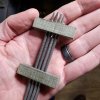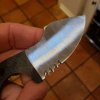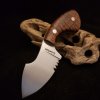- Joined
- Jan 5, 2014
- Messages
- 1,495
I recently got a request for a Bread knife, and I have to admit in all these years, I've not made a serrated edge blade, so I am asking for advice on how to make a serrated edge, and also how to sharpen one.
I would appreciate any info/advice
Thanks--Don
I would appreciate any info/advice
Thanks--Don




